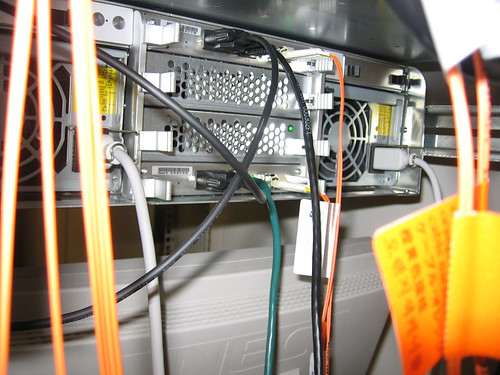-make a tape backup and remove the files from the network
-burned a lot of CD's and remove the files from the network
-burned DVD's and remove the files from the network
-copy the project to a NAS device
-copy the project to cheap large IDE/SATA drives
That is a basic timeline of our archive process. This has become very inefficient. Even though everything was properly labeled and could be found it was still inefficient. Why? It could take a long time to search through the amount of single backup tapes, CD's, DVD's and archive locations on the network and NAS devices for a specific piece of data. Also the data was all over the place as you can see.
We resolved these problems by revisiting centralized storage again. An expensive SAN for dead storage is a waste of a lot of money (depending on your environment and your budget). A bunch of cheap storage is also a waste b/c you will be buying A BUNCH of device eliminating the centralization factor. Also when those device get remodeled and decommissioned you are stuck with a bunch of devices of different storage sizes and device shapes and styles. Our choice was Apples Xserve RAID.
We decided on the Apple Xserve RAID after careful research. Our biggest question was b/c it was an apple product will our Windows servers see the storage? Also will our Windows servers see a volume over 2 TB. Windows use to have a 2 TB limit on their volumes. This was back in the early Windows 2000 server days. Then Microsoft came out with Dynamic disks. Where you can use 2 basic disks to create a dynamic disk larger than 2 TB. Read more about it here,
After we were confident that our servers will be able to create a volume over 2 TB we placed the order for their 7 TB Xserve RAID. It cost us $13,000. Talk about cheap storage.
The device is by no means a cheap POS though. It has 2 storage processors, 2 fiber connections, 2 power supplies and 14 hot swap Ultra ATA 500GB drives. This is a very nice piece of hardware just like all of apple's hardware products they did not slack on this one. As good as it looks it was even easier to setup. The has 2 of everything including network interfaces. These interfaces are set for DHCP so you just plug the device in and they are on your network. Apple's RAID Admin tool that comes with OS X but they also have a Java based one for Windows environments finds the device on your network. You can now change the IP's of both interface to conform with your server or storage device IP addressing. within in RAID Admin you can manage the device like any other enterprise level storage device. We are not using the Xserve RAID as a true SAN so will are not managing drive space in that manner. We are using it as NAS on steroids or a limited SAN. Why I say that is b/c we have connected the Xserve RAID to our fiber channel switch and zoned it out to it's host server. Our Windows 2003 server detects the Xserve RAID as if it were an internal drive or a SAN drive.
So far the Xserve RAID is working great. After creating the partition in Windows disk manager and waiting 28 hours for the drives to initialize (yes 28 hours) the device has been working flawlessly. Windows 2003 server sees 5.5 TB out of the 7 TB raw so keep that in mind that you will lose 1.5 TB to overhead. We have populated the device with 2.5 TB or archive data so far and we still have a lot of data left to add. Will we needs another one soon? I hope so b/c these device are very nice to have on your network. It just makes managing and centralizing storage so easy, cheap and simple.
Front of Apple Xserve RAID

Back of Apple Xserve RAID

No comments:
Post a Comment